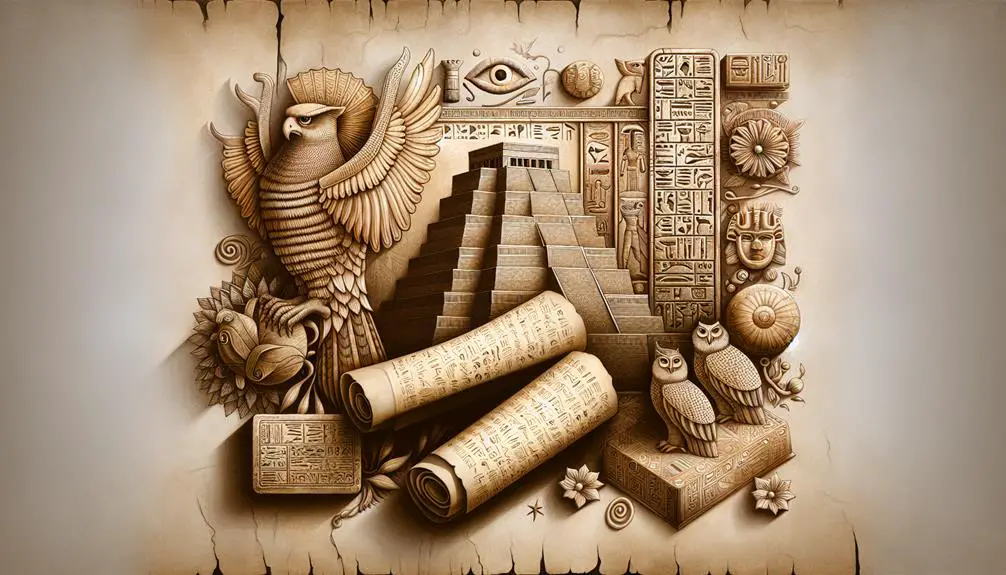Navigating the intricate landscape of plagiarism in the Bible reveals a tapestry of inspiration and imitation, challenging modern perceptions of originality.

Plagiarism in the Bible
The concept of plagiarism in the context of the Bible presents a complex and nuanced issue that challenges contemporary notions of originality and intellectual property.
As we embark on an exploration of this topic, it is crucial to consider the historical context in which Biblical texts were written, including the prevalent practices of textual borrowing and adaptation among ancient cultures.
The examination of literary parallels and shared motifs across different traditions raises intriguing questions about the boundaries of inspiration and imitation. By scrutinizing these intersections, we stand on the threshold of reevaluating what we understand about the transmission and transformation of sacred texts across millennia, inviting a deeper consideration of their significance in a modern context.
Key Takeaways
- Biblical plagiarism involves complex considerations of authorship and cultural exchange, not easily assessed by modern standards.
- The Bible's text reflects a tapestry of shared themes and legal concepts from Ancient Near Eastern cultures.
- Intertextuality and shared narrative motifs in biblical stories highlight the communal nature of ancient text creation.
- Scholarly debates continue over the nature and extent of literary borrowing within the Gospels, influenced by oral traditions and communal memory.
Defining Biblical Plagiarism

Understanding biblical plagiarism necessitates a precise definition, often entailing the unauthorized use or close imitation of language and thoughts from within the Bible without proper acknowledgment. This concept introduces a multifaceted analysis, especially when considering the diverse authorship and compilation history of biblical texts. Authorship debates play a pivotal role in discussions of biblical plagiarism. The Bible, a compilation of texts written over centuries by various authors, presents unique challenges in attributing originality and ownership. Scholars scrutinize these texts to discern the original sources and intentions behind their creation, often encountering overlapping themes and narratives that cross traditional authorial boundaries.
Ethical concerns emerge as a significant aspect of this discourse. The act of borrowing or imitating language and thoughts without acknowledgment, while viewed in a contemporary context as plagiarism, necessitates a nuanced understanding when applied to sacred texts. The ethical framework surrounding biblical texts differs markedly from secular literature, complicating the application of modern plagiarism standards. This complexity is heightened by the communal nature of these texts' creation and their intended purpose of conveying religious truths rather than claiming originality.
In analyzing biblical plagiarism, it is essential to navigate these ethical considerations and authorship debates with scholarly rigor. The objective is not to undermine the spiritual value or integrity of the biblical texts but to understand the historical and cultural practices that shaped their formation. This approach requires a delicate balance between acknowledging the unique nature of sacred literature and applying critical analysis to explore its composition and transmission.
Historical Context of Textual Borrowing

Throughout history, the practice of textual borrowing within the Bible has been a complex phenomenon, reflecting the intertwined evolution of religious, cultural, and literary traditions. This practice, often enveloped in controversy, necessitates a nuanced understanding of the historical context in which these texts emerged. The dynamics of authorship anonymity and cultural acceptance have played pivotal roles in shaping the perceptions and practices of textual borrowing within biblical literature.
Several key factors contribute to the complexity of textual borrowing in the Bible:
- Cultural Contexts of Composition: The Bible was written across diverse cultures and epochs, where the concept of authorship and originality significantly differed from contemporary understandings. In many ancient cultures, retelling and integrating existing stories into new compositions was a respected practice, encouraged for its ability to convey moral and theological truths.
- Authorship Anonymity: The anonymity of many biblical authors complicates discussions of plagiarism. Without clear authorial claims, the intention behind textual borrowing remains speculative, often interpreted within the framework of divine inspiration rather than individual creativity.
- Oral Tradition Influence: Much of the biblical text originated from oral traditions. This oral foundation inherently involves a process of adaptation and incorporation, blurring the lines between original and borrowed content.
- Cultural Acceptance: In the biblical era, the reuse of texts and ideas was widely accepted, even expected, as a means of affirming and propagating cultural and religious values. This cultural acceptance provides a backdrop against which the practice of textual borrowing must be analyzed, differentiating it from modern notions of plagiarism.
Understanding the historical context of textual borrowing in the Bible requires an appreciation for the complexities of authorship, cultural practices, and the evolving nature of literature and religious expression.
Literary Analysis of Similar Passages

Building on the historical context of textual borrowing within the Bible, a closer literary analysis of similar passages can reveal the nuanced interplay between original composition and borrowed elements. This examination is pivotal for understanding how authors in biblical times utilized stylistic devices and authorial intent to craft narratives that, while reflective of earlier traditions, stand as unique literary compositions.
An analytical comparison of passages involves dissecting the language, themes, and narrative techniques employed. Below is a table showcasing examples of these elements in comparative analysis:
Element |
Borrowed Passage |
Original Composition |
|---|---|---|
Theme |
Deliverance from adversity |
Covenant and faithfulness |
Language |
Repetitive phrasing for emphasis |
Unique metaphors and similes |
Narrative Technique |
Direct narration |
Use of dialogue and rhetorical questions |
This table highlights how borrowed passages might share themes with their sources but differ significantly in the execution of language and narrative technique. The use of repetitive phrasing in a borrowed passage, for instance, may serve a different function from unique metaphors in an original composition, reflecting differing authorial intents. Similarly, while the theme of deliverance is common, the original composition might explore it through the lens of a covenant, emphasizing the relationship between deity and believers through stylistic devices like dialogue.
Through such literary analysis, it becomes evident that biblical authors engaged in a sophisticated process of adaptation and innovation. Understanding the interplay of borrowed elements and original composition not only enriches our appreciation of the Bible's literary depth but also underscores the dynamic nature of its textual tradition.
Ancient Near Eastern Influences

The examination of Ancient Near Eastern influences on biblical texts reveals a complex intertextuality. Particularly in the realms of creation narratives, legal codes, and mythological motifs. This comparative analysis highlights shared themes and structures that suggest a cultural exchange or common intellectual heritage between these ancient civilizations and the authors of the Bible.
Identifying these parallels does not diminish the uniqueness of the biblical text. Rather, it situates it within a broader historical and cultural context.
Shared Creation Narratives
Ancient Near Eastern cultures significantly influenced the creation narratives found within the Bible, sharing thematic elements and motifs that illuminate the interconnectedness of these ancient societies. The mechanisms of cultural diffusion and the role of oral traditions were pivotal in the transmission and evolution of these stories, demonstrating a complex web of cultural interplay.
- Cultural Diffusion: The movement of creation myths across borders, adapting to local contexts.
- Oral Traditions: The role of storytellers in preserving and transmitting creation narratives.
- Motifs of Chaos and Order: Common themes of bringing order from chaos found across narratives.
- Deity Interactions: Similar interactions between gods and creation, reflecting shared understandings of divine agency.
This analysis underscores the richness and diversity of ancient storytelling, highlighting the shared human endeavor to understand the origins of existence.
Legal Code Parallels
Several legal codes from Ancient Near Eastern societies exhibit remarkable parallels with laws found within the Bible, reflecting a deep-seated exchange of legal concepts and principles across civilizations. This mutual influence underscores the interconnectedness of ancient societies and challenges the notion of isolated development of legal systems.
The analysis of these parallels through the lens of Copyright Law and Modern Ethics offers a fascinating perspective on the transmission of legal ideas over time. It poses questions about originality and adaptation in the context of ancient legal formulations.
The comparison encourages a reevaluation of how we understand the development of legal norms, suggesting that ancient laws, much like copyright in the modern era, were subject to influences and adaptations that transcended cultural and geographical boundaries, thus shaping the ethical foundations of societies in a collective manner.
Mythological Motifs Comparison
Exploring beyond the legal frameworks, a comparative study of mythological motifs reveals another dimension of Ancient Near Eastern influence on biblical narratives. This exploration, grounded in scholarly analysis, highlights the intricate ways these narratives intertwine, particularly through:
- Heroic archetypes that resonate across cultures, suggesting a shared mythological heritage.
- Symbolic parallels in creation stories, underscoring universal themes of chaos, order, and divinity.
- Flood narratives that bear striking resemblances, pointing to a common mythological understanding of divine judgment and renewal.
- Motifs of divine battles and victories, reflecting a broader Near Eastern narrative tradition.
These elements not only enrich our understanding of the biblical text but also invite a broader consideration of the intertextuality that characterizes the ancient literary landscape.
New Testament and Synoptic Gospels

The Synoptic Gospels—Matthew, Mark, and Luke—share a significant amount of content, narrative structure, and wording, raising questions about their intertextual relationships and the phenomenon often referred to as literary borrowing within the New Testament. This similarity has sparked extensive authorship debates, with scholars examining the possibility that later Gospels might have iteratively borrowed from earlier texts. The matter is further complicated by translation variations that arise from the passage of these texts through different languages and historical contexts.
Gospel |
Characteristic Example of Borrowing |
|---|---|
Mark |
Often considered the primary source due to its simplicity and chronology. |
Matthew |
Expands on Mark, adding genealogies and sermon materials. |
Luke |
Shares content with Mark, but also incorporates unique parables. |
John |
Significantly differs but is not considered synoptic. |
This table demonstrates the intertextual dynamics among the Synoptic Gospels, highlighting the complex nature of their literary relationships. The phenomenon suggests a shared source or an intricate process of adaptation and revision among the texts, contributing to ongoing scholarly discussions. The focus on authorship debates and translation variations underscores the challenges in understanding the origins and development of these foundational Christian texts.
In addressing these complexities, a scholarly approach requires careful examination of historical contexts, linguistic nuances, and the theological intentions behind the texts. Understanding the Synoptic Gospels' intertextual relationships not only informs debates around literary borrowing in the New Testament but also contributes to broader discussions on the nature of textual transmission and adaptation in ancient religious literature.
Scholarly Perspectives on Originality

In the realm of biblical studies, scholarly perspectives on originality are deeply divided, reflecting a spectrum of views on the extent and nature of literary borrowing among the Synoptic Gospels. This debate centers on understanding how ancient texts were composed, shared, and preserved, intersecting with broader discussions on authorship debates and the mechanisms of cultural transmission. The following points highlight key aspects of this discourse:
- Varied Definitions of Originality: Scholars disagree on what constitutes originality in ancient literary contexts, with some arguing that the reuse of sources was a common and accepted practice, while others see it as reducing the uniqueness of each Gospel.
- Authorship Debates: Questions surrounding the identities of the Gospel authors and their possible reliance on shared sources or oral traditions contribute to the complexity of determining originality. These debates often hinge on understanding the cultural and historical context of authorship in the ancient world.
- Cultural Transmission Practices: The role of oral tradition and communal memory in the transmission of the Gospels is pivotal, with some scholars emphasizing the fluid nature of storytelling and its impact on the perceived originality of the texts.
- Intertextual Analysis: Modern scholarly methods, such as intertextual analysis, shed light on the ways the Gospels may have borrowed from each other and from other Jewish and Greco-Roman texts, offering insights into the cultural web of influence and exchange.
Through these lenses, discussions on originality in the Bible reveal the complexities of literary creation and cultural transmission in the ancient world, challenging simplistic notions of plagiarism and authenticity.
Implications for Modern Believers

While scholarly debates on originality within the Synoptic Gospels continue, it is crucial to consider how these discussions impact the faith and understanding of modern believers. The contention that certain passages or concepts may have been borrowed or adapted from earlier texts introduces ethical dilemmas and challenges for those who see the Bible as a foundational pillar of their faith. For believers, the notion of plagiarism in sacred scripture can provoke a crisis of faith, calling into question the divine inspiration and the uniqueness of their religious texts.
However, this situation also offers an opportunity for a deeper engagement with the Bible. Understanding the historical and cultural context in which these texts were written can enrich one's faith, revealing a more nuanced view of divine inspiration. It suggests that the process of revelation might be more complex and intertwined with human history than previously thought. This perspective encourages believers to embrace a faith that is informed by historical-critical scholarship, fostering a more resilient and dynamic relationship with their sacred texts.
Moreover, the discussions around originality and borrowing in the Bible prompt modern believers to reflect on the nature of ethical dilemmas within their own faith traditions. How does one reconcile the sacredness of scripture with the human elements of its composition? This reflection can lead to a more profound understanding of faith, one that accepts the imperfections of human authors while still recognizing the transformative power of the texts they composed.
Frequently Asked Questions
How Do Different Religious Denominations Address and Interpret the Concept of Plagiarism With Respect to the Bible?
Different religious denominations approach the concept of scriptural authenticity and theological interpretations with varying degrees of scrutiny and methodologies.
The question at hand delves into how these groups reconcile or address the notion of originality within their sacred texts.
Through an analytical lens, denominations may employ historical-critical methods, tradition-based exegesis, or doctrinal teachings to navigate interpretations, ensuring their understanding aligns with both spiritual integrity and scholarly rigor.
Are There Any Legal Implications or Historical Instances of Copyright Disputes Involving the Bible Due to Claims of Plagiarism?
Analyzing the legal implications or historical instances of copyright disputes concerning ancient texts, it's essential to consider the evolution of copyright laws and the originality of these texts.
While modern legal frameworks protect intellectual property, ancient texts, including religious scriptures, predate these laws. Consequently, claims of plagiarism within such texts seldom lead to legal disputes due to the complexities of proving originality and ownership historically, coupled with the sacred status of religious documents.
How Do Contemporary Authors and Creators Navigate the Balance Between Being Inspired by Biblical Texts and Avoiding Plagiarism?
Contemporary authors and creators navigate a delicate balance when drawing inspiration from biblical texts, aiming for a blend of creativity and originality. This process involves a nuanced grasp of the line between homage and plagiarism. Through scholarly analysis, it is evident that incorporating biblical narratives into one's work while preserving a distinctive voice is a multifaceted task. It necessitates profound reverence for the source material and a dedication to authentic individual expression.
In What Ways Have Modern Technologies, Such as Digital Text Comparison Tools, Impacted the Study and Identification of Potential Plagiarism in Ancient Texts, Including the Bible?
Modern technologies, particularly digital text comparison tools, have significantly advanced the study of ancient texts. These tools facilitate the identification of textual similarities and differences, thus contributing to the assessment of manuscript authenticity.
However, the use of algorithms in these analyses introduces the potential for algorithmic bias, which scholars must carefully navigate.
Such innovations have transformed our approach to understanding historical texts, ensuring a more nuanced interpretation of their origins and evolution.
Beyond Textual Similarities, How Do Music, Art, and Other Forms of Cultural Expression Engage With and Potentially Replicate Biblical Themes or Narratives Without Constituting Plagiarism?
In exploring how cultural expressions such as music and art engage with biblical themes, it is essential to differentiate between plagiarism and artistic reinterpretation.
Musical motifs and visual arts often draw inspiration from biblical narratives, embodying them in ways that transcend mere textual replication. This process of creative engagement allows for the exploration of universal themes within a contemporary context, enriching the cultural tapestry without directly infringing on the original biblical texts.
Conclusion
In summary, the examination of alleged plagiarism within the biblical texts, through a historical, literary, and theological lens, underscores the complexity of defining originality in ancient religious scriptures.
The intertextuality between the Bible and earlier Near Eastern texts, such as the similarities found between the flood narratives in the Epic of Gilgamesh and the Book of Genesis, exemplifies the nuanced process of textual borrowing.
This analysis invites a reevaluation of the concepts of authorship and originality in sacred literature, urging modern believers to appreciate the layered history of their faith's foundational texts.



Sign up